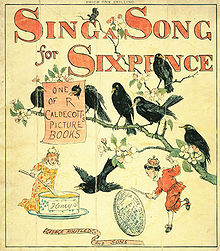Common blackbird
The common blackbird was described by Carl Linnaeus in his landmark 1758 10th edition of Systema Naturae as Turdus merula (characterised as T. ater, rostro palpebrisque fulvis).[6] About 65 species of medium to large thrushes are in the genus Turdus, characterised by rounded heads, longish, pointed wings, and usually melodious songs.[8] It may not immediately be clear why the name "blackbird", first recorded in 1486, was applied to this species, but not to one of the various other common black English birds, such as the carrion crow, raven, rook, or jackdaw.Another variant occurs in Act 3 of Shakespeare's A Midsummer Night's Dream, where Bottom refers to "The Woosell cocke, so blacke of hew, With Orenge-tawny bill".[8] The Central Asian subspecies, the relatively large intermedius, also differs in structure and voice, and may represent a distinct species.[21] Recoveries of blackbirds ringed on the Isle of May show that these birds commonly migrate from southern Norway (or from as far north as Trondheim) to Scotland, and some onwards to Ireland.[29] As long as winter food is available, both the male and female will remain in the territory throughout the year, although occupying different areas.[16] The male common blackbird attracts the female with a courtship display which consists of oblique runs combined with head-bowing movements, an open beak, and a "strangled" low song.[31] The nominate T. merula may commence breeding in March, but eastern and Indian races are a month or more later, and the introduced New Zealand birds start nesting in August (late winter).[8][25] The breeding pair prospect for a suitable nest site in a creeper or bush, favouring evergreen or thorny species such as ivy, holly, hawthorn, honeysuckle or pyracantha.The male's song is a varied and melodious low-pitched fluted warble, given from trees, rooftops or other elevated perches[37] mainly in the period from March to June, sometimes into the beginning of July.[39] At least two subspecies, T. m. merula and T. m. nigropileus, will mimic other species of birds, cats, humans or alarms, but this is usually quiet and hard to detect.Near human habitation the main predator of the common blackbird is the domestic cat, with newly fledged young especially vulnerable.[42][43] However, there is little direct evidence to show that either predation of the adult blackbirds or loss of the eggs and chicks to corvids, such as the European magpie or Eurasian jay, decrease population numbers.The benefit of this is that the bird can rest in areas of high predation or during long migratory flights, but still retain a degree of alertness.[53][55] The introduced common blackbird is, together with the native silvereye (Zosterops lateralis), the most widely distributed avian seed disperser in New Zealand.Introduced there along with the song thrush (Turdus philomelos) in 1862, it has spread throughout the country up to an elevation of 1,500 metres (4,921 ft), as well as outlying islands such as the Campbell and Kermadecs.[56] It eats a wide range of native and exotic fruit, and makes a major contribution to the development of communities of naturalised woody weeds.[60] Like many other small birds, it has in the past been trapped in rural areas at its night roosts as an easily available addition to the diet,[61] and in medieval times the practice of placing live birds under a pie crust just before serving may have been the origin of the familiar nursery rhyme:[61] Sing a song of sixpence, A pocket full of rye; Four and twenty blackbirds baked in a pie![64] The common blackbird, unlike many black creatures, is not normally seen as a symbol of bad luck,[61] but R. S. Thomas wrote that there is "a suggestion of dark Places about it",[65] and it symbolised resignation in the 17th century tragic play The Duchess of Malfi;[66] an alternate connotation is vigilance, the bird's clear cry warning of danger.[69] French composer Olivier Messiaen transcribed the songs of male blackbirds; these melodies have commonly appeared throughout his œuvre.





Conservation statusLeast ConcernIUCN 3.1Scientific classificationEukaryotaAnimaliaChordataPasseriformesTurdidaeTurdusBinomial nameLinnaeusspeciestrue thrushNew World blackbirdsintroducedsubspecieslatituderesidentmigratorynominate subspeciesplumageomnivorousinsectsearthwormsberriesfruitsterritorialtemperateCarl Linnaeus10th edition of Systema Naturaesong thrushmistle thrushCanary Islandsisland thrushcarrion crowjackdawOld Englishmodern EnglishShakespeare'sA Midsummer Night's DreamBottomring ouzelwhite-throated dipperthrusheswhite-collared blackbirdgrey-winged blackbirdIndian blackbirdTibetan blackbirdChinese blackbirdconspecificSomali thrushicteridNew World warblerstanagerscowbirdsgracklesred-winged blackbirdmelodious blackbirdIcelandFaroesUral MountainsNile ValleyCyprusAzoresÁngel CabrerazoologistMadeiraMoroccoAlgeriaTunisiaTurkeyJordanIsraelJordan ValleyNile DeltaTajikistanT. maximusOxfordshireleucisticGran Canariacommon starlingChiguanco thrushNederlandsche VogelenjuvenilesedentarymigrateoverwinterIsle of MayTrondheimQuebecBonavista, NewfoundlandNorth American listhawthornhoneysucklepyracanthaaltriciallife expectancybird ringingNorthern Hemispherebirds of preyLausanneleaf litterinvertebratesamphibianslizardsmammalscaterpillarskestrelsparrowhawkaccipiterscorvidsEuropean magpieEurasian jayparasiticcuckooscommon cuckoonon-mimeticIntestinal parasitesIsosporaCapillariaLeucocytozoonPlasmodiumHaemoproteusTrypanosomaIxodes